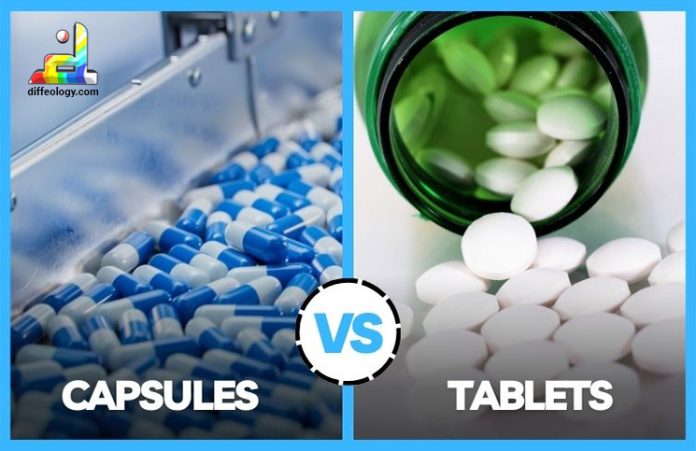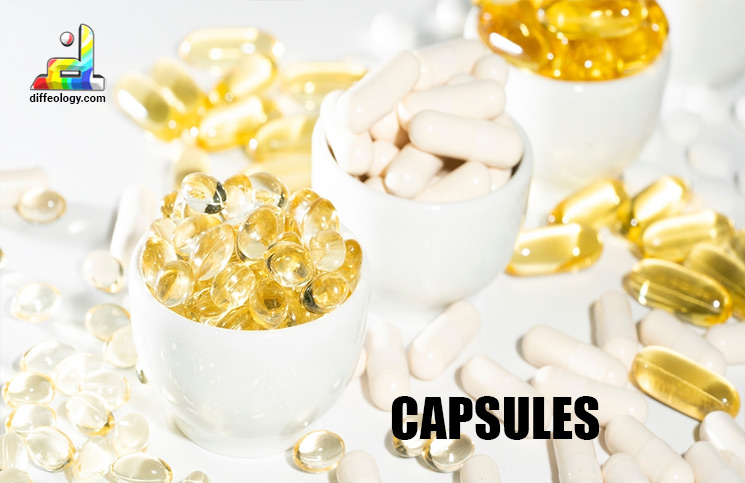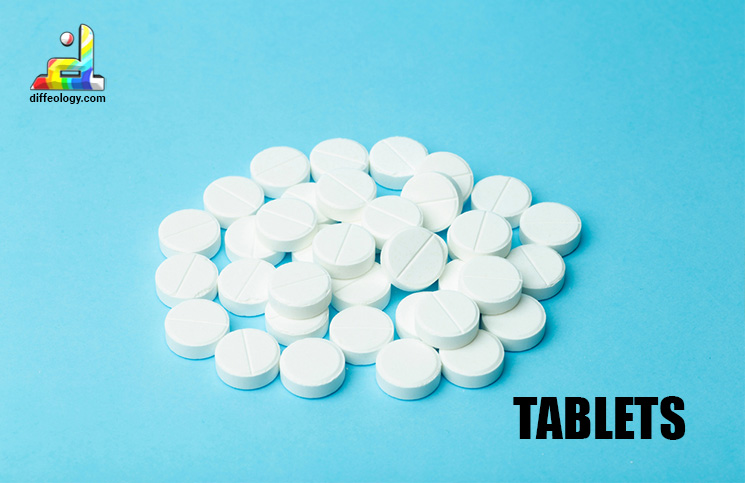You may have come across varying formats of medication, such as pills and capsules. Two major means used in the delivery of drugs have separate properties that affect the way your body assimilates and responds to the treatment. It’s important to understand the Difference Between Capsules and Tablets so that you can make health-based decisions. Now, let’s talk about particular aspects of each kind and see how these things affect digestibility, absorption, and convenience.
Main Difference Between Capsules and Tablets
Typically, capsules consist of two separate gelatine pieces filled with powdery or liquid medicine. They are solid, compressed forms of medicine that usually have hard coatings on them.
These can be filled with different substances ranging from liquid and powder fillers to empty capsules. However, a tablet is normally made with active components and additives for facilitation during manufacture.
Their capsules have gelatinous layers that make them dissolve at high speed compared to tablets. Dissolving tablets in the digestive system might be slower.
The capsules may help absorb faster in the digestive tract as they dissolve quicker. The length of time required for disintegration may cause tablets to absorb more slowly.
It is coated with an outer layer of gelatin or vegetables. Different types of tables can be sugared or enteric-coated.
Capsules Vs. Tablets
What are Capsules?
Capsules are specialized oral dosage forms used for the administration of medicine. The containers are very small, cylindrical, or oval-shaped and come in two halves, that is, made from a gelatine or a vegetable product. The two half sides are called a shell that may consist of drug powder or liquid. Capsules form a major packaging for different categories of drugs, such as antibiotics, vitamins, and herbs, among others.
The outer cover has different functions in the capsule. Additionally, it keeps the medicine safe and shields the content from external forces such as air and moisture. Different types of shells, like gelating or other vegetable-based alternatives, are used with regard to particular dietary or religious prohibitions. The uniqueness of the capsule is that it quickly dissolves, which causes a speedy discharge of the medicine into the digestive tract. The absorption rate is normally higher than that of other popular forms, such as tablets, which exhibit this characteristic.
Read Also: Difference Between Paracetamol and Ibuprofen
The capsules are available in various aspects and perform different functions. An example is a soft gel capsule, which contains liquid and provides the option of liquid medicines, unlike hard shell capsules that are often used for powder substances. Besides, capsules are multi-purpose, allowing for a combination of multiple drugs and preparations in one dosing form.
What are Tablets?
One of the most popular forms of oral pharmaceutical medication is tablets. Tablets are different from capsules as they are solid and compressed forms of medicine. These are formed by combining active materials and different excipients that are compressed to aid production. There are diverse shapes of tablets ranging from round or oval to oblong tablets that are often coated for a certain purpose.
Tablet stability is among its unique features. Being solid, the tablets are also more resistant to the effects of humidity and air, which makes the drug expiry date shorter. These tablets can be coated with sugar as a taste-masked or an enteric layer to shield the drug content from acid in the stomach, which dissolves only in the small intestine. Additional tablets are sometimes scorable so as to allow for convenient breaking into halves and quarters for flexible dosage.
Read Also: Difference Between Vitamin D and D3
Disintegrates in the digestive system and tablets are taken by mouth. The rate of disintegration will determine the extent of release of the medicine, and it will depend on the type of tablet formulation. Directly dissolving tablets supply a rapid start, and prolonged-release tablets give their drug out slowly and for a long time. These products have become increasingly preferred in pharmacies due to their convenience, ease of manufacture, and the possibility of producing different tablets with varying drugs for varied patient cases.
Comparison Table “Capsules Vs. Tablets”
| Form | Capsules are gelatinous shells with medication. | Tablets are solid, compressed forms of medication. |
| Ingredients | It can contain powders, liquids, or fillers. | Composed of active ingredients and excipients. |
| Digestion Time | Often dissolve quickly in the digestive system. | It may take longer to dissolve in the digestive tract. |
| Absorption Rate | Absorbed quickly due to fast disintegration. | It may have a slower absorption rate. |
| Coating | Have a gelatin or vegetable-based outer coating. | It can have various coatings, like sugar or enteric. |
| Taste | Typically tasteless due to the capsule shell. | It may have a taste influenced by coatings or contents. |
| Customization | Allows combining different medications easily. | Limited in combining multiple medications. |
| Stability | Offers protection, enhancing stability. | Susceptible to environmental factors affecting stability. |
| Ease of Swallowing | It is generally easier to swallow for some individuals. | May be harder to swallow due to their solid nature. |
| Manufacturing Process | Involves encapsulation, often automated. | Manufactured through compression processes. |
| Breakability | It cannot be easily broken or divided. | It may be scored for easy breaking into halves or quarters. |
| Appearance | Distinct oval or cylindrical shape. | Various shapes, including round, oval, or oblong. |
| Preservation | Better protection against moisture and air. | It may require special packaging for stability. |
| Cost | It can be more expensive due to encapsulation. | Generally more cost-effective in production. |
| Disintegration | Disintegrates quickly, releasing medication. | It may take time to disintegrate before release. |
| Storage | Generally more stable in varying conditions. | Sensitive to temperature and humidity variations. |
| Dosage Forms | Available in soft gels and hard shells. | Different formulations, including immediate or extended-release. |
| Allergen Considerations | Vegetable-based capsules may suit allergies. | It may contain allergens in excipients like lactose or gluten. |
Difference Between Capsules and Tablets in Detail
1. Formulation and Composition:
Their compositions vary greatly. Typically, capsules are prepared using two components made of gelatin and enclosing a viscous or granular drug. When it comes to masking up the taste and odor of the drug, this kind of covering will facilitate the patient’s intake. The drugs taken in non-tablet form, such as pressed powdered tablets, are, however, different. Tablets are usually comprised of some additives such as binders, fillers, and disintegrates that help them to bond together properly and disintegrate easily in the stomach.
What will be contained in capsules and tablets is dependent on the properties of the drug and its intended effects. The drug depends on the parameters of stability, solubility, and bioavailability; the former may go into capsules, while the latter is best presented via tablets.
2. Absorption and Bioavailability:
The bioavailability of capsules and tablets depends upon how well their absorption takes place in the body. It refers to the proportion of the drug that enters the circulation system when the drug is administered in the organism. The absorption by the body of another pill could be enhanced compared to other kinds.
Nevertheless, tablets tend to take longer to disintegrate in the food pathway, hence slow drug absorption as well. Some tablets have been designed to stay longer, with the intent of releasing drugs slowly, as an extended period of medication. Sustained delivery will enable a continuous therapeutic impact, thereby reducing the frequency of dosage administration.
3. Ease of Swallowing:
One major distinction between pills and tablets involves easy swallowing. The capsule’s outer cover is made up of soft gelatin, which makes it easier to ingest than other medicine forms. First, it creates a smooth surface that allows the liquid to move down the esophagus by capsules in this two-part design.
However, many people with a “weak” throat or strong gag reflex might find it difficult to swallow tablets. However, tablets are consolidated; hence, they seem big and unfair compared to capsules. Some tablets can be split or scored for ease of swallowing, while other tablets are of a whole-dose form.
In a nutshell, comparing various drug attributes and the patient expectation levels would assist in deciding between giving capsules and tablets. The prescriptions of various drugs are made on the basis of the benefits versus problems that come along with every specified dosage form.
4. Shelf Life and Stability:
The shelf life and stability also differ among capsules and tablets. Incorporation of components in capsules would shield against harmful agents like moisture and oxygen, which could preserve the medication. It might be simply vital here for susceptible-to-degradation medicines. Nevertheless, tablets might have very high absorption and exposure because of their compressed condition, resulting in a broader surface area than nature.
Adequate medication stability determines the efficacy and safety of medicines. They should also be very cautious about choosing an appropriate dosage because these drugs need to be active until they expire and their shelf life expires.
5. Manufacturing Process:
Capsule and tablet manufacturing processes vary greatly. The capsules are made using pre-shaped gelatine cases filled with liquid or powder drugs. Lastly, they are finally sealed to give us the final formulation. This presents an avenue where the formulation and dosages can be adapted based on different types of drugs and their different strengths.
However, in comparison to tablets, the compression of powdered ingredients into tablet form press. Nonetheless, some level of discretion will be needed on the part of the formula so as to come up with good bonding and fragmented characters. In most cases, tablets are made according to a specific routine; however, they can involve special aspects like taste masking or extended-release formula.
6. Cost Considerations:
Capsule or tablet selection is also influenced by the cost element. Although it is generally highly automated, capsule production is more complex and typically involves additional machines for encasing the capsules. The other thing that may add to the costs is the utilization of gelatin covering the capsule. Nevertheless, the compression methods for tablets can be done easily using generic tools, which makes them cheaper than other processes at hand.
The selection of dosage forms often involves a cost consideration that takes into account patient out-of-pocket expenses as well as healthcare provider costs. One can look into non-branded versions of such medicines that may have been packaged into capsule and/or tablet forms based on one’s buying power.
7. Patient Preference and Adherence:
Medication adherence, as well as patient preference, depends upon treatment success. Some individuals might choose the drug in one dosage form over another because of ease of swallowing, pleasant taste, or perceived convenience. People have different tastes, which play a very significant role in healthcare. The providers strive to maintain high patient compliance with prescriptions based on these tastes.
Usually, going for capsules versus tablets is a tough decision considering factors like quality of the drug, manufacturing mode, stability, cost vs benefit relationship, and patients’ preference, among others. However, there are advantages and disadvantages to using different doses, which health practitioners and patients share in the decision-making of the best one to use.
8. Disintegration and Dissolution:
One of the notable differences between a capsule and a tablet is the dissolution and disintegration properties. Dissipation is a breakdown of the dosage state into smaller pieces and disintegration, where drug particles are absorbed into the blood. The capsule typically dissolves directly upon contact with body fluids, leading to rapid disintegration. Drugs that need to be quickly decomposed and absorbed benefit from this process of quick dissolution.
Nonetheless, tablet disintegration and/or dissolution may vary depending on formulation type or methodological approach.0page: Some tablets dissolve on administration and have an extremely fast rate of absorption. Specifically, other delayed-release pills and extended-release tablets exhibit such a tendency. This is simply one area in which questions of capsules or tablets often depend on what kind of pharmacokinetic profile the desired drug needs.
9. Taste and Odor Masking:
The means by which a drug will be formulated as either a capsule or tablet for taste and odor masking is also crucial. These capsules are gellaciously coated, which conceals the taste and smell of the drug within. This is particularly important for unpalatable and repugnant drugs, thereby promoting better patient adherence to medication.
However, flavor masking of distinct-tasting medication can be a challenge that may come with tablets. These may, however, present problems for manufacturers who want to make their tablets tasty through the use of flavor or any other coating agents. This is preferable, particularly should taste-masking would be fundamental to these states of affairs.
10. Flexibility in Dosage Formulation:
Secondly, the administration of doses is flexible with these two drugs (tablets and capsules). Capsules have been more flexible in combining different drug formulations into the same dosage form. This is illustrated by an example whereby a capsule may consist of multiple membrane layers or compartments with different medications and/or release rates. These have been termed “multiparticulate” or “multilayered” capsule technologies, giving options for dosage delivery strategies.
Nevertheless, tablets might be more complicated, and they cannot combine multiple ingredients of different drugs into a single pill. However, there are some forms in relation to using a tablet, which include bilayer and multilayer, giving room for choice. Therefore, it may just be about what one requires out of such a tablet.
11. Risk of Tampering and Misuse:
Risk of medication tampering and unauthorized use is also a major component of medication safety. The capsules are gelatin-coated, which makes them very difficult to manipulate. Capsule’s integrity allows for seeing any possible tampering, such as an opening. Therefore, this is a major factor that, by all means, should never be missed where there is a high probability of either overdose or choking.
Tablets that are not tightly coated or divided by scoring are particularly vulnerable to tampering. Capsules are also preferable in a matter of intentional/ unintentional misuse. These are some abuser-deterrent extended-release tablets whose formulation makes them hard to tamper with.
12. Environmental Impact:
This adds an additional concern related to the possible impact of various pharmaceutical dosage forms on the environment. Generally, capsules would be more environmentally friendly since such materials, including gelatin or other polymers, are natural and thus biodegradable. They may come in the form of animal gelatines from bones that consist of the bones and the cartilage. They have another kind known as vege that consists of plants made from cellulose, which is commonly marketed from vegan stores.
The decay of tablets into environmental contaminants may be extended due to their composition. Examples of such may be non-relatable elements of coating and binder for tablets. Drug manufacturers and healthcare providers can take into account the environmental impact when considering sustainability issues.
As such, their differences include structural and physical aspects, deterioration, organoleptic applications, formulated products, susceptibility to fraud, and environmental issues. These considerations are useful when healthcare professionals choose a dose form for any purpose, such as deciding on a dose form.
Key Points Showing the Difference Between Capsules and Tablets
- Taste: Capsules may be tasteless, as the medication is enclosed in a shell. Tablets may have a taste that can be influenced by the coating or ingredients.
- Customization: Capsules allow for the combination of different medications or formulations. Tablets are more limited in combining multiple medications due to their solid form.
- Stability: Capsules can protect ingredients from external factors, enhancing stability. Tablets may be more susceptible to environmental factors affecting stability.
- Ease of Swallowing: Capsules are generally easier to swallow for some individuals. Tablets may be harder to swallow due to their solid nature, especially for those with difficulty swallowing.
- Manufacturing Process: Capsules involve encapsulating the medication, often through automated processes. Tablets are manufactured through compression, involving pressing ingredients into a solid form.
- Breakability: Capsules cannot be easily broken or divided. Tablets may be scored or designed for easy breaking into halves or quarters.
- Appearance: Capsules have a distinct oval or cylindrical shape. Tablets come in various shapes, including round, oval, or oblong.
- Preservation: Capsules may offer better protection against moisture and air. Tablets may require special packaging to maintain stability.
- Cost: Capsules may be more expensive to manufacture due to the encapsulation process. Tablets can be more cost-effective in terms of production.
- Disintegration: Capsules disintegrate quickly, releasing the medication. Tablets may take some time to disintegrate before the medication is released.
- Storage: Capsules are generally more stable in varying storage conditions. Tablets may be sensitive to temperature and humidity variations.
- Dosage Forms: Capsules are available in various forms, including soft gels and hard shells. Tablets can have different formulations, such as immediate-release or extended-release.
- Allergen Considerations: Capsules may be suitable for individuals with gelatin allergies if made with a vegetable-based capsule. Tablets may contain allergens like lactose or gluten in the excipients.
FAQs: Capsules Vs. Tablets
Conclusion:
In the world of pharmaceuticals, the choice between capsules and tablets is not about preference but Aspects such as rate of absorption, ease of swallow, and even stability and cost involved in manufacture are some of the elements that are considered while making such a decision. Although capsules grant fast absorption and adaptive mixes, tablets ensure affordability and divide effortlessly.
Knowing this list of Difference Between Capsules and Tablets allows you to choose between a capsule and a tab, and this empowers you to select what is best for your health. In this regard, capsule vs. tablet clarifies the terrain on which we make decisions regarding our medicinal preferences, and it makes these choices specific to us since they are guided by knowledge.
References & External Links
- Choosing the Right Type of Pill: Capsules, Tablets, Softgels, and More






